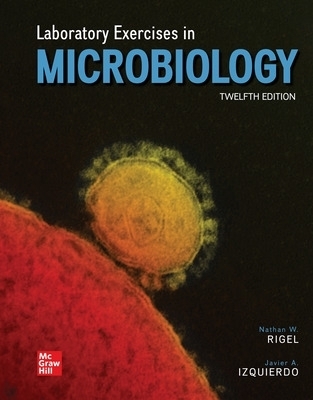
Laboratory Exercises in Microbiology
McGraw-Hill Education (Verlag)
978-1-264-77566-8 (ISBN)
Nathan W. Rigel is an associate professor in the Department of Biology at Hofstra University. Since starting his lab in 2013, Dr. Rigel’s research has focused on the various protein trafficking pathways of Acinetobacter. While at Hofstra, Dr. Rigel has taught courses in microbiology, cell and molecular biology, bioinformatics, and bacterial genetics. Dr. Rigel completed his undergraduate studies in Microbiology at the Pennsylvania State University. He then moved south and earned his PhD in Microbiology and Immunology at the University of North Carolina at Chapel Hill while studying the accessory SecA2 protein export system found in mycobacteria. In 2009, Dr. Rigel returned north to study assembly of outer membrane proteins in Gram-negative bacteria as a postdoctoral research associate in the Department of Molecular Biology at Princeton University. Originally from a small town in central Pennsylvania, Dr. Rigel now lives in Queens with his wife and son. He can be reached at nathan.w.rigel@hofstra.edu. Javier A. Izquierdo is an associate professor at Hofstra University, where he started his lab in 2014. Dr. Izquierdo received his BS in Biology at Case Western Reserve University. He earned his PhD in Microbiology from the University of Massachusetts Amherst, where he studied soil microbial ecology, and where he developed a passion for teaching microbiology thanks to many wonderful mentors. He went on to Dartmouth College for his postdoctoral work on the microbial ecology of cellulose degradation by anaerobic thermophiles. He then served as Biofuels Program Manager at the Research Triangle Institute in North Carolina, but his interests in teaching and mentoring research students brought him back to academia. His research group at Hofstra continues to work on understanding the ecology and physiology of cellulolytic microbes, as well as studying root-associated microbiomes of plants growing under stressful conditions. At Hofstra, he has taught courses in general microbiology, genomics and bioinformatics, and environmental microbiology. He enjoys going on long walks along the coast or the mountains with his wife and daughters. He is also a singer-songwriter and an avid photographer. He can be reached at javier.a.izquierdo@hofstra.edu.
PART ONE
Microscopic Techniques
1. Bright-Field Light Microscopy and Microscopic Measurement of Organisms
2. The Hanging Drop Slide and Bacterial Motility
3. Dark-Field Light Microscopy
4. Phase-Contrast Microscopy
PART TWO
Bacterial Cell Biology
5. Aseptic Technique
6. Negative Staining
7. Simple Staining
8. Gram Stain
9. Acid-Fast Staining Procedure
10. Endospore Staining
11. Capsule Staining
12. Flagella Staining
PART THREE
Basic Culture Techniques
13. Preparation of Microbiology Media and Equipment
14. The Spread-Plate Technique
15. The Streak-Plate Technique
16. The Pour-Plate Technique
17. Cultivation of Anaerobic Bacteria
18. Determination of Bacterial Numbers
PART FOUR
Microbial Biochemistry
19. Carbohydrates I: Fermentation and β-Galactosidase Activity
20. Carbohydrates II: Triple Sugar Iron Agar Test
21. Carbohydrates III: Starch Hydrolysis
22. Lipid Hydrolysis
23. Proteins I: The IMViC Tests
24. Proteins II: Gelatin and Casein Hydrolysis
25. Proteins III: Catalase Activity
26. Proteins IV: Oxidase Test
27. Proteins V: Urease Activity
28. Proteins VI: Lysine and Ornithine Decarboxylase Tests
29. Proteins VII: Phenylalanine Deamination
30. Proteins VIII: Dissimilatory Nitrate Reduction
PART FIVE
Environmental Factors Affecting Growth of Microorganisms
31. Temperature
32. pH
33. Osmotic Pressure
34. The Effects of Chemical Agents on Bacteria I: Disinfectants and Other Antimicrobial Products
35. The Effects of Chemical Agents on Bacteria II: Antibiotics
36. Bacterial Growth Curve
PART SIX
Environmental and Food Microbiolog
37. Monitoring Water for Coliforms
38. Enumeration of Soil Microorganisms
39. Winogradsky Columns
40. Bioluminescence
41. Plate Counts and Quality Assessment of Milk
PART SEVEN
Medical Microbiology
42. Staphylococci
43. Pneumococcus
44. Streptococci
45. Neisseriae
46. Normal Human Flora
PART EIGHT
Eukaryotic Microbiology
47. Fungi I: Yeasts (Ascomycota)
48. Fungi II: Zygomycota (Rhizopus), Ascomycota (Penicillium), and Basidiomycota (Agaricus)
| Erscheinungsdatum | 17.03.2022 |
|---|---|
| Zusatzinfo | 158 Illustrations |
| Verlagsort | OH |
| Sprache | englisch |
| Gewicht | 928 g |
| Themenwelt | Naturwissenschaften ► Biologie ► Mikrobiologie / Immunologie |
| ISBN-10 | 1-264-77566-0 / 1264775660 |
| ISBN-13 | 978-1-264-77566-8 / 9781264775668 |
| Zustand | Neuware |
| Haben Sie eine Frage zum Produkt? |
aus dem Bereich


